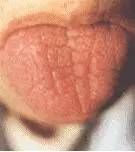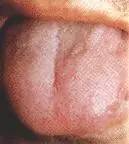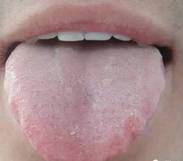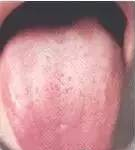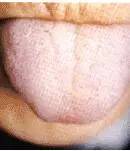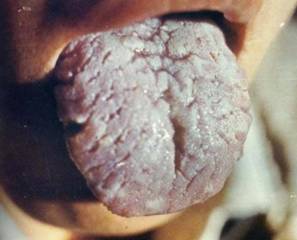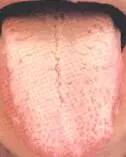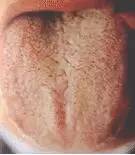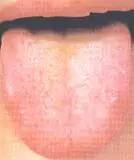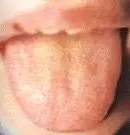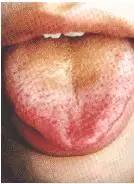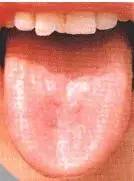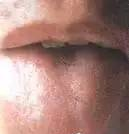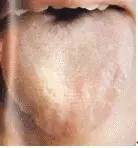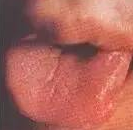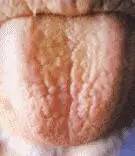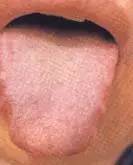In Traditional Chinese Medicine (TCM), diagnosis involves the four examinations: observation, listening, inquiry, and palpation. Only by integrating these four diagnostic methods can one more accurately determine the underlying pathology, especially as pulse diagnosis reflects real-time and precise conditions.
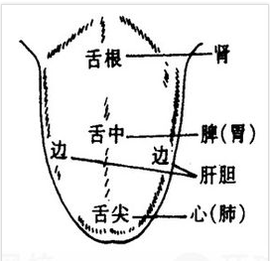
However, among these four examinations, the general public can greatly benefit from self-examination through tongue observation and changes in tongue coating to assist in understanding their overall health and disease status. Below are several common tongue coatings and their diagnoses:
Normal Tongue Appearance: The tongue body is soft, flexible, and light red in color, with a thin, evenly distributed, moderately moist white coating, often described as “light red tongue with thin white coating.”
Observing the tongue primarily involves examining the changes in tongue quality and coating.The tongue quality, also known as the tongue body, refers to the muscular and vascular structure of the tongue.
The tongue coating is a layer of fur-like substance attached to the tongue body, generated by stomach qi. The term “stomach qi” refers to the healthy transformation and transportation by the spleen, with the stomach being responsible for receiving and digesting (indicating normal digestive function). When the spleen and stomach function normally, a thin and moist tongue coating can be observed.
During pathological changes in the body, the fluctuations of yin and yang, the harmony of qi and blood, and the existence of body fluids can all be directly reflected in changes in the tongue coating. By observing changes in the tongue coating, one can infer the condition of the internal organs (organ dysfunction) and the severity of disease (progression of illness).
Cracked Tongue
Illustration: The tongue surface shows various cracks of differing depths and shapes, referred to as a cracked tongue.
Main Conditions and Related Research:Cracked tongue is often a sign of yin deficiency with excessive heat.
Main Conditions of Cracked Tongue:
(1) Excessive heat injuring yin, often presenting as a red tongue with cracks;
(2) Blood deficiency leading to lack of moisture, often presenting as a pale tongue with cracks;
(3) Spleen deficiency with dampness, often presenting as a pale, swollen tongue with teeth marks and cracks. Treatment should focus on nourishing yin essence, benefiting qi, and generating fluids; tonifying the spleen and draining dampness; nourishing yin and clearing heat; clearing heat and moistening dryness. Additionally, a cracked tongue refers to cracks in the tongue body as well as in the tongue coating; during diagnosis, one should differentiate based on the dryness or moisture of the coating. If the cracks are due to dryness, it indicates an external pathogenic disease with heat injuring fluids, leading to severe dryness.
If the coating is moist and cracked, it is often due to qi deficiency. Modern research suggests that shallow cracks on the tongue are primarily due to atrophy of the tongue mucosa, causing the longitudinal or transverse grooves to become visible, while deep cracks indicate more severe atrophic changes in the tongue, leading to loss of normal structure in the tongue epithelium, with some papillae flattening and merging, while others atrophy and crack, revealing thickened scar tissue beneath.
Swollen Tongue
Illustration: A swollen tongue appears large and puffy, or with teeth marks on the edges, and is pale and tender.
Main Conditions and Related Research: The swollen tongue is also discussed in ancient texts as being related to a swollen tongue. In fact, a swollen tongue is caused by deficiency of the spleen’s yang qi, or combined with cold dampness, leading to a large, puffy, tender, pale tongue, often with teeth marks, which is a sign of deficiency and should be distinguished from a swollen tongue.
Main Conditions of Swollen Tongue:
(1) Spleen deficiency, presenting as a large, tender tongue with a pale color. The tongue edges have teeth marks, the coating is thin and white, the complexion is pale and cold, with little energy and a tendency to be lethargic, abdominal fullness, loose stools, and a weak or slow pulse.
This is often due to water retention and phlegm dampness obstructing the tongue, causing it to swell. If the tongue is pale, tender, and moist, it indicates spleen and kidney yang deficiency, with qi unable to transform fluids, leading to water dampness rising. Treatment should focus on strengthening the spleen and benefiting qi, using formulas like Li Zhong Tang or Bu Zhong Yi Qi Tang.
Clinically, this is often seen in patients with obesity, hypothyroidism, anemia, etc. Commonly used TCM formulas include: Ren Shen Jian Pi Wan, Huo Xiang Zheng Qi Wan, Shen Ling Bai Zhu Wan, Fu Zi Li Zhong Wan, Jia Wei Bao He Wan, etc.
(2) Kidney deficiency with water retention, presenting as a large, tender tongue with a pale color, teeth marks on the edges, significant swelling below the waist, scanty urination, cold limbs, a dull or pale complexion, a slow or weak pulse. Treatment should focus on warming yang and promoting urination, using Jin Gui Shen Qi Wan, Zhen Wu Tang, etc. Additionally, if the tongue is pale and swollen with a yellow greasy coating, it often indicates damp-heat in the spleen and stomach, with phlegm turbidity rising. Treatment should focus on transforming dampness and eliminating phlegm, using Yin Chen, Mu Tong, Hua Shi, Shi Gao, and Zhi Zi to clear heat and drain dampness. Clinically, this is often seen in patients with chronic glomerulonephritis, pyelonephritis, etc. Commonly used TCM formulas include: Jin Gui Shen Qi Wan, Ji Sheng Shen Qi Wan, Bu Yao Jian Shen Gao, Shen Yan Wen Yang Pian, Shen Yan Xiao Zhong Pian, etc.
Teeth-marked Tongue
Illustration: A teeth-marked tongue shows impressions of teeth along the edges of the tongue.
Main Conditions and Related Research: A teeth-marked tongue is often caused by the tongue body being swollen and pressed by the teeth, thus it is often seen alongside a swollen tongue. It is mostly associated with spleen deficiency and is a sign of deficiency syndrome. If the tongue is pale and moist, it indicates spleen deficiency with cold dampness.
The cause of a teeth-marked tongue is often due to spleen deficiency failing to transform water and dampness, leading to dampness obstructing the tongue and causing it to swell, which is then pressed by the teeth, resulting in the marks. Therefore, a teeth-marked tongue is often seen alongside a swollen tongue, as it can be due to tongue edema, which is a sign of spleen yang deficiency and excess dampness, or due to relaxation of the tongue muscles, leading to insufficient opening of the mouth, which is a sign of spleen qi deficiency.
Main Conditions of Teeth-marked Tongue:
— Pale and moist with teeth marks, indicating excess cold dampness;
— Pale red with teeth marks, indicating spleen deficiency or qi deficiency;
— Red and swollen, with teeth marks, indicating damp-heat phlegm obstruction;
In summary, it can be divided into qi deficiency and yang deficiency types:
(1) Qi deficiency type: Spleen qi deficiency, main symptoms: tongue quality is pale, tongue coating is thin and white, tongue body is swollen and tender, tongue edges have teeth marks, complexion is pale or sallow, shortness of breath, lethargy, fatigue, abdominal distension, loose stools, and a weak pulse. Treatment should focus on tonifying the spleen and benefiting qi.
(2) Yang deficiency type: Main symptoms: tongue quality is pale, tongue surface is moist with much fluid, or tongue surface is slippery, tongue body is round, large, tender, with teeth marks. The complexion is pale or dark, fatigue, lethargy, preference for warmth, no thirst, reduced appetite, cold abdominal pain, relief from warmth, cold limbs, clear urination, or edema, with a weak pulse. Treatment should focus on warming and tonifying yang. Commonly used TCM formulas include: Ren Shen Jian Pi Wan, Huo Xiang Zheng Qi Wan, Shen Ling Bai Zhu Wan, Fu Zi Li Zhong Wan, Jia Wei Bao He Wan, etc.
Thin White Coating
Illustration: A thin white coating covers the tongue surface, with evenly distributed granules. The moisture is moderate.
Main Conditions and Related Research:A thin white coating, with a light red and moist tongue, is the most common tongue coating under normal conditions, indicating “stomach qi is present.” The formation of a thin white coating is primarily due to the combined effects of chewing, swallowing, and saliva in the oral cavity, which continuously removes and sheds substances between the filiform papillae of the tongue mucosa and the keratinized epithelium, resulting in only a thin white layer of coating on the tongue.
Formation of Thin White Coating: However, when external pathogens such as wind-cold, wind-dampness, or cold-dampness invade (the six excesses include: wind, cold, heat, dampness, dryness, and fire), and the disease is still superficial (in the early stage), not yet penetrating deeper (worsening or developing), and the pathogenic factors (disease condition) are relatively mild, the qi of the internal organs (organ function) is not harmed, a thin white coating is often observed. Hence, there is a saying that “thin white coating indicates superficial conditions.”
According to the “Guide to Tongue Diagnosis,” it states, “If the tongue coating is white, moist, and thin, the pathogen is in the wei level (in TCM, the wei, qi, ying, and blood levels are classified into four layers of disease severity, with wei being the lightest level), and sweating can be used (to expel the pathogen)… such as with Ma Huang and Qiang Huo.” Commonly seen thin white and moist tongue coatings, with normal tongue quality, are often associated with external wind-cold conditions. If accompanied by chills and fever, body aches, and stiff neck, with no sweating or little sweating, a floating tight pulse, one can use Ma Huang Tang with modifications; if the tongue quality is red, with a thin white and moist coating, it indicates external wind-heat or external wind-cold transforming into heat, and one can use Yin Qiao San with modifications. Commonly used TCM formulas include: Gan Mao Qing Re Chong Ji, Tong Xuan Li Fei Kou Fu Ye, etc.
Thin White Dry Coating
Illustration: Thin white dry coating: The white coating is thin on the tongue surface, with less fluid and a tendency to be dry.
Main Conditions and Related Research:A thin white dry coating is due to injury to both lung fluids and qi, where qi deficiency leads to an inability to transform fluids, and with less fluid, there is insufficient moisture for the tongue, causing the coating to dry out.
Main Conditions of Thin White Dry Coating: Often due to wind-heat entering the lungs, where the pathogenic qi injures the lungs, or due to yang deficiency failing to transform fluids and moisten the tongue. The former should clear and moisten dryness, using Yin Qiao San with methods to nourish yin and clear heat; the latter should benefit qi and generate fluids, using Xuan Fei Yi Qi Tang to warm and benefit qi. If the above thin white dry coating is accompanied by symptoms of cold, cough, and white phlegm, reference can be made for medication. Commonly used TCM formulas include: Qing Re Yang Yin types—Yin Qiao Jie Du Wan, Yin Qiao Jie Du Chong Ji, Yin Huang Kou Fu Ye, Qiong Ju Shang Qing Wan, Qing Re Jie Du Kou Fu Ye, Yang Yin Qing Fei Wan, Yang Yin Qing Fei Kou Fu Ye, Shuang Huang Lian Kou Fu Ye, and Xuan Fei Yi Qi types—Tong Xuan Li Fei Wan, Tong Xuan Li Fei Kou Fu Ye, Ji Zhi Tang, Zhi Ke Ju Hong Kou Fu Ye.
Thick White Greasy Coating
Illustration: Thick white greasy coating: The tongue shows a white coating that is thick, with tightly packed or loose granules, which can cover the entire tongue or be thinner at the edges.
Main Conditions and Related Research:A thick white greasy coating is often due to insufficient yang qi in the middle jiao, leading to food stagnation, or due to dampness and phlegm accumulation. The “Guide to Tongue Diagnosis” states: “A white greasy coating indicates chest oppression and pain, irritability, and dry vomiting; one often desires to drink water, but water leads to vomiting. This is due to heat caused by food stagnation, and one should use light and bland methods to transform the stagnation.”
Main Conditions of Thick White Greasy Coating: It indicates dampness, phlegm, and cold. If the tongue coating is white and greasy due to external cold-dampness, it indicates the invasion of cold-dampness. Cold causes the color to be white, while dampness leads to a greasy coating; since cold-dampness is superficial, the tongue may appear thin and greasy. Treatment should focus on warming and dispersing cold-dampness, using Qiang Huo Sheng Shi Tang. If the white greasy coating is due to internal dampness, it indicates the invasion of damp-heat pathogens. Damp-heat enters the interior, accumulating between the membranes. Yang qi is obstructed, and dampness rises, leading to a thick white greasy coating on the tongue, or a coating that appears like accumulated powder.
Treatment should focus on transforming dampness and clearing heat, using Da Yuan Yin. If the tongue coating is white and greasy due to internal cold-dampness, it indicates spleen yang deficiency, leading to water retention and a thick greasy coating. Treatment should focus on warming yang, strengthening the spleen, and promoting urination, using Wen Pi Tang.
— It is worth noting that heat caused by food stagnation leads to the accumulation of dampness and turbid pathogens, which rise to the tongue, causing a thick white greasy coating without yellow coating; however, there is still internal heat, so one may observe irritability and dry vomiting, indicating that this condition is different from damp-heat leading to yellow coating. Clinically, this is often seen in patients with bronchial asthma, pulmonary emphysema, pulmonary heart disease, rheumatic heart disease, and heart failure. This type of tongue appearance is generally associated with complex conditions, and treatment should be based on differential diagnosis. Some commonly used TCM formulas for this type of tongue appearance include: Xiao Qing Long He Ji, Su Zi Jiang Qi Wan, Zhi Sou Ding Chuan Kou Fu Ye, Yu Ping Feng Kou Fu Ye, Yang Shen Bao Fei Kou Fu Ye, Ge Jie Ding Chuan Wan, Sheng Mai San Kou Fu Ye, Guan Xin Sheng Mai Kou Fu Ye, Huo Xin Wan, Xue Fu Zhu Yu Kou Fu Ye, and Yi Xin Kou Fu Ye.
White Coating Dry Cracked Tongue
Illustration: A white coating dry cracked tongue appears with a white coating that can be thin or thick, with rough and loose granules, dry and hard, resembling sand or stone, and if the granules are finer and the texture is hard, it may have longitudinal and transverse cracks, referred to as a dry cracked white coating.
Main Conditions and Related Research: Both white coating and dry cracked conditions can appear on the tongue surface, hence collectively referred to as dry cracked white coating. This is primarily due to internal heat rising rapidly, leading to severe injury to body fluids. It is often seen in acute warm diseases, where heat rises rapidly, injuring fluids, and true yin is about to be exhausted, while the coating has not yet turned yellow. If the coating is white and cracked but not too dry, it is often seen in summer heat, where summer heat injures qi, and dampness is mixed in.
The “Tongue Diagnosis” states: “A white coating dry cracked tongue is due to mistakenly taking warming tonics, injuring true yin, and if there is no yellow or black color, it indicates that true yin is about to be exhausted, with the tongue lacking moisture and the coating having dried out, hence unable to show other colors.”
Main Conditions of White Coating Dry Cracked Tongue: It indicates excessive heat injuring fluids; treatment should focus on generating fluids and clearing heat; it indicates summer heat injuring qi, with dampness mixed in, and treatment should focus on clearing summer heat and benefiting qi. Clinically, this is often seen in patients with external warm diseases and acute infectious diseases. Commonly used TCM formulas include: Zi Xue San, Ling Qiao Jie Du Wan, Ban Lan Gen Chong Ji, etc.
Yellow Greasy Coating
Illustration: A yellow greasy coating: The tongue shows a yellow and greasy coating, with tightly packed granules, and a yellow powdery substance applied to the tongue surface.
Main Conditions and Related Research: A yellow greasy coating forms due to the intersection of pathogenic heat and phlegm dampness. The yellow coating indicates heat, while the greasy coating indicates dampness, phlegm, and food stagnation.
Main Conditions of Yellow Greasy Coating: It indicates damp-heat accumulation, phlegm transforming into heat, or food stagnation transforming into heat; it also indicates external summer heat, damp warmth, etc. Treatment should focus on clearing heat, transforming dampness, and eliminating phlegm. Additionally, when diagnosing yellow greasy coating, one should also consider the tongue quality.
— If the tongue is light red, with a yellow coating covering the tongue surface, the coating is moist and not dry; if the edges and tip have a little white coating, it indicates that the external pathogen has penetrated deeper, transforming into heat, entering the yangming stomach and intestines. The main condition is heat entering the yangming, qi level damp-heat syndrome, liver and gallbladder diseases, and urinary tract infections, as well as various febrile diseases. Treatment should focus on clearing heat and detoxifying, unblocking the exterior and interior.
— If the tongue is red, with a yellow greasy coating that is medium thick and thinner at the edges, tightly packed and fine, especially at the root, it often indicates that heat phlegm is intermingled, or dampness has entered the interior and transformed into heat, or warm heat pathogens have accumulated in the stomach and intestines, not yet reaching the yangming level.
— If the tongue is deep red and has a yellow greasy coating, it indicates a severe condition of deep heat in the nutrient level; the main condition is heat phlegm intermingling, middle jiao damp-heat, and food stagnation in the stomach and intestines. Treatment should focus on clearing heat, transforming dampness, and eliminating stagnation. — If the tongue is purple, with a gray-yellow thick coating, moist but not dry, it indicates a mixed condition of cold and heat, where heat transforms from cold, or cold transforms from heat, indicating a critical condition, often due to unresolved heat illness, severe heart yang deficiency, prolonged phlegm retention, and external pathogens entering the interior and transforming into heat; excessive summer heat, overconsumption of cold foods leading to internal cold diarrhea; excessive yin within, forcing heat to rise; or pre-existing blood stasis combined with external pathogens transforming into heat; thus, the main condition is true cold with false heat, heart and kidney yang deficiency, and various symptoms such as diarrhea and asthma. Treatment should focus on warming the heart and kidney, reviving yang; clearing heat and transforming stagnation; and invigorating blood and resolving stasis.
— If the tongue is dark purple, with a yellow greasy coating, the tongue body is swollen, and the tongue surface is covered with yellow coating, with a thicker coating at the root, it may be due to yin conditions affecting food, phlegm dampness accumulating, cold pathogens stagnating, or damp food obstructing the middle jiao, leading to qi and blood stagnation, or damp-heat and food residues in the stomach and intestines. Treatment should focus on warming yang, strengthening the spleen, and invigorating blood to resolve accumulation.
Clinically, this tongue appearance is often seen in patients with acute and chronic gastroenteritis, cholecystitis, and uremia. This type of tongue appearance is generally associated with complex conditions, and treatment should be based on differential diagnosis.
Yellow Dry Coating
Illustration: A yellow dry coating appears on the tongue, indicating a yellow color and dryness with little fluid (fluids). This indicates a pathological change due to heat injuring fluids.
Main Conditions and Related Research: The causes of yellow dry coating are varied:
(1) A thin yellow coating that is dry indicates that the external pathogen has transformed into heat and penetrated deeper, injuring fluids;
(2) A yellow coating that is dry indicates excessive heat in the qi level, where fluids have been injured;
(3) A dry yellow coating that is thick indicates a condition of internal heat;
(4) If the coating is old yellow, dry, and prickly, or has cracks, it indicates that the external pathogen has been resolved, and the pathogenic qi has penetrated deeper, accumulating in the internal organs.
(5) If the coating changes from thick to thin, and the color changes from deep to light, dry with little fluid, it indicates that the pathogenic heat has retreated, but fluids have not yet been generated.
Main Conditions of Yellow Dry Coating: Pathogenic heat penetrating deeper, treatment should focus on clearing heat and purging the interior. Excessive heat in the qi level injuring fluids, treatment should focus on using cold and bitter herbs to clear heat and protect fluids. Internal heat conditions, where pathogenic heat accumulates in the internal organs, treatment should focus on using bitter cold herbs to purge and clear heat. If the heat has retreated but fluids are still injured, treatment should focus on using sweet cold herbs to generate fluids. Since yellow dry coating often combines with complex main conditions, the choice of medication should also be based on the specific condition. Commonly used TCM formulas for clearing heat and detoxifying include: Qing Re Jie Du Wan, Xin Qing Ning Pian, Zi Xue San, An Gong Niu Huang Wan, etc.
Yellow Coating
Illustration: Yellow coating is a common pathological tongue coating, which can also be seen in some healthy individuals.
Main Conditions and Related Research: The yellow coating seen in healthy individuals is primarily thin yellow coating and thin yellow greasy coating. Thick yellow greasy coating tends to increase with age. The yellow coating can vary in color from light yellow, tender yellow, deep yellow, to burnt yellow, often distributed at the root and central part of the tongue, and can also cover the entire tongue. As previously mentioned, yellow coating can also be seen alongside other colors such as white coating, and among various yellow coatings, there are differences in thickness, moisture, and greasiness.
Main Conditions of Yellow Coating: It indicates spleen and stomach diseases, internal conditions, and heat conditions. The “Comprehensive Guide to Tongue Diagnosis” states that yellow coating can be present in both excess heat conditions and deficiency cold conditions. Pathogenic heat scorching leads to the appearance of yellow coating, with light yellow indicating mild heat; deep yellow indicating severe heat; burnt yellow indicating heat accumulation. In external pathogenic diseases, the tongue coating changes from white to yellow, indicating that the external pathogen has penetrated deeper and transformed into heat, in febrile diseases, it belongs to the yangming level; in warm diseases, it belongs to the qi level. However, both external conditions and deficiency cold conditions can also present with yellow coating: if the coating is thin white with a light yellow coating, it indicates wind-heat external conditions or wind-cold transforming into heat; if the coating is light yellow and thick, it indicates chest cavity damp-heat, with qi stagnation. If the tongue is tender and moist with a yellow coating, it indicates yang deficiency with water retention. Therefore, yellow coating is a basic indicator of internal conditions but not absolute.
Modern research on the formation mechanism of yellow coating includes: (1) The formation of yellow coating is related to elevated body temperature; (2) Yellow coating is associated with inflammatory infections; (3) Yellow coating is related to digestive dysfunction; (4) Yellow coating is associated with microbial activity. In summary, researchers believe that yellow coating is most closely related to infections, inflammation, and fever, leading to digestive dysfunction, resulting in the proliferation of filiform papillae on the tongue, reduced secretion from the salivary glands, and local discoloration, along with inflammatory exudation and microbial activity, collectively forming yellow coating.
Thin Yellow Coating
Illustration: The tongue has a yellow coating, with thin yellow coating being a light yellow coating mixed with thin white coating.
Main Conditions and Related Research: Thin yellow coating is a common pathological tongue coating, which can also be seen in some healthy individuals. Commonly seen yellow coating is primarily thin yellow coating and thin yellow greasy coating. Thick yellow greasy coating tends to increase with age. Thin yellow coating often develops from white coating, indicating that the condition has transformed from cold (one of the six excesses) into heat, penetrating deeper (worsening or prolonging the disease).
The “Treatise on Febrile Diseases” states: “If the yellow coating is thin and floating, it indicates that the heat is in the lungs and has not yet entered the stomach.” Here, the lungs refer to the qi level (the lightest level in TCM), while the stomach refers to the internal condition (deeper level).
— If the thin yellow coating is moist, it often indicates that the external pathogen has just entered the interior, with internal heat not being severe, and fluids not being injured; treatment should focus on clearing heat and penetrating the exterior (expelling the pathogen from the superficial level through sweating);
— If the thin yellow coating is dry, one should differentiate whether the patient has a preference for heat rather than cold, indicating that the external pathogen has just entered the yangming (stomach) level, or that warm heat pathogens are about to enter the qi level, indicating that there is heat in the stomach but not yet severe. Treatment should focus on using sweet cold herbs to nourish and moisten fluids;
— If the tongue is thin white with a light yellow coating, it indicates wind-heat in the exterior or wind-cold transforming into heat, and treatment should focus on using pungent and cool herbs to resolve the exterior.
The above thin yellow coating may be accompanied by: (1) Fever, headache, dry throat, fatigue, cough with yellow phlegm, etc., and can try using herbs that clear heat and penetrate the exterior. Commonly used TCM formulas include: Yin Qiao Jie Du Wan, Yin Qiao Jie Du Chong Ji, Yin Huang Kou Fu Ye, Qiong Ju Shang Qing Wan, Qing Re Jie Du Kou Fu Ye, Yang Yin Qing Fei Wan, Yang Yin Qing Fei Kou Fu Ye, Shuang Huang Lian Kou Fu Ye, etc.
(2) If there is a significant fever with mild chills, sore throat, cough with yellow phlegm, etc., one can try using light sweet cold herbs. Commonly used TCM formulas include: Anti-Viral Oral Liquid, Jin Lian Qing Re Chong Ji, Yin Qiao Jie Du Chong Ji, etc.
(3) For more severe symptoms, in addition to the above medications, one can also try using Qing Fei Yi Huo Wan, Zhu Li Hua Tan Wan, etc.
Gray Coating
Illustration: Gray coating: The tongue shows a grayish-black coating.
Main Conditions and Related Research: Strictly speaking, gray coating and black coating have different colors and associated conditions. However, as the coating darkens, it becomes gray; if it is deep gray, it is considered black. Gray coating generally indicates a milder condition, while black coating indicates a more severe condition, closely related to the progression and outcome of the disease.
Gray coating often develops from darkened white coating or can be seen alongside yellow coating. The “Guide to Tongue Diagnosis” states: “Gray coating is a lighter form of black coating. If it is mixed with green and yellow, it becomes gray, and should be treated similarly to black coating.” Generally, it indicates internal conditions, but there are also distinctions between cold and heat.
The “Treatise on Febrile Diseases” states: “If the tongue coating is gray-black and slippery, it indicates that cold water is invading the earth, indicating a cold condition in the taiyin.”… Treatment should focus on regulating the middle jiao. If gray-black slippery coating appears with mixed symptoms, it indicates that phlegm dampness is injuring the spleen, and treatment should focus on warming the middle jiao, harmonizing the spleen, and eliminating phlegm. Gray coating that is moist often indicates phlegm dampness retention, while dry gray coating often indicates heat injuring fluids, seen in external warm diseases or yin deficiency with excessive fire, indicating internal injuries from mixed diseases; pathogenic heat penetrating deeper, epidemic diseases, blood stasis, etc., can also present with gray coating.
Main Conditions of Gray Coating: Dry gray coating indicates yangming organ excess, with yin fluids injured. If there is excess in the organs, treatment should focus on using bitter cold herbs to purge; if there is no excess in the organs, with a fine rapid pulse, treatment should focus on using bitter cold herbs to rescue fluids. If gray coating is sticky, it indicates phlegm dampness retention, with warm diseases combined with phlegm dampness; if accompanied by other severe symptoms, further differentiation is needed. Treatment should focus on warming the middle jiao, drying dampness, and using aromatic herbs to clear and transform. Gray coating that is slippery and moist, with fine rapid pulse, indicates yang deficiency with cold symptoms; treatment should focus on warming yang and dispelling cold, using Si Ni Tang, Li Zhong Tang, etc. Additionally, gray coating can indicate cold, heat, or damp conditions, and clinical differentiation should consider tongue quality, moisture, and other symptoms.
Burnt Yellow Coating
Illustration: Burnt yellow coating: The tongue appears with a burnt yellow coating, which can be thick and deep yellow, especially at the center or root.
Main Conditions and Related Research:Burnt yellow coating indicates the presence of internal heat in the stomach. The “National Medicine Tongue Diagnosis” states: “If the coating is yellow and dry, it indicates injury to stomach fluids; if it is old yellow and burnt, it indicates severe heat; if it is old yellow and black, it indicates extreme heat resembling water, requiring urgent treatment; if it is yellow and dry with prickly texture, it indicates corruption in the stomach and intestines.” If the tongue quality is pale white with a burnt yellow coating at the root, it indicates a larger tongue body, pale tongue quality, and a tongue tip with a yellow coating mixed with white, with the root being dry and lacking fluids, presenting a burnt yellow appearance. Yellow coating indicates excessive heat in the stomach, often due to pathogenic factors penetrating deeper and transforming into heat; or heat pathogens directly entering the yangming, with warm pathogens entering the qi level, leading to a burnt yellow coating at the root, indicating severe injury to stomach and kidney yin fluids.
Main Conditions: Yangming organ excess, excess heat in the three jiao, or late-stage warm diseases, with injury to stomach and kidney yin, as well as various febrile diseases and infectious diseases. Treatment should focus on using bitter cold herbs to purge and clear heat, and generate fluids. Additionally, if the tongue is red with a burnt yellow coating, with a red tongue body and purple edges, and a burnt yellow coating at the root, it indicates the invasion of external pathogens, transforming into fire and penetrating deeper, injuring the nutrient blood, leading to fluid loss, and excessive heat in the stomach and intestines, resulting in insufficient yin fluids.
Pathogenic heat and residues accumulate in the stomach, leading to dryness of fluids, causing the tongue quality to change from red to burnt yellow, and the coating color to change from yellow to burnt yellow, indicating fluid depletion. The main condition is warm heat pathogens entering the nutrient blood, or combined with yangming excess heat conditions, various infectious diseases, and prolonged fever. Treatment should focus on clearing heat, unblocking the interior, cooling the blood, and detoxifying. Due to the complexity of burnt yellow coating, it is often seen in various clinical diseases, and treatment should be based on differential diagnosis.
Pale White Tongue with Insufficient Fluids
Illustration: The tongue shows insufficient fluids, or even no fluids at all.
Main Conditions and Related Research: A pale white tongue with insufficient fluids is often due to yang qi deficiency, which fails to generate fluids, or due to yang deficiency leading to water retention, where fluids cannot nourish the tongue.
Main Conditions of Pale White Tongue with Insufficient Fluids: Yang qi deficiency leads to insufficient fluids. Treatment should focus on supporting yang, benefiting qi, and generating fluids. Clinically, this is often seen in patients with chronic atrophic gastritis, mild anemia, etc. If the above tongue appearance is accompanied by: spleen and stomach disharmony—abdominal fullness, lack of appetite, bland taste in the mouth, vomiting, nausea, heavy limbs, thick white greasy coating, and a slow pulse, one can try using herbs that strengthen the spleen and dry dampness; spleen and stomach yang deficiency—subtle abdominal pain, vomiting clear fluids, preference for warmth and pressure, reduced appetite, fatigue, pale tongue quality, and a weak pulse, one can try using herbs that strengthen the spleen, open the appetite, and promote qi to resolve fullness; commonly used TCM formulas include: Ping Wei Wan, Xiang Sha Zhi Shi Wan, Xiang Sha Yang Wei Wan, Li Zhong Wan, Huang Qi Jian Zhong Wan, Xiang Sha Liu Jun Zi Wan, etc.
Pale White Tongue with Stasis
Thin white, pale white tongue with stasis spots.
Main Conditions and Related Research:Pale white tongue with stasis: Previous literature has rarely discussed pale white tongue with stasis (spots), but clinically, this tongue appearance does exist. Analyzing its formation, it is often related to blood deficiency combined with stasis. Modern research on tongue microcirculation has found that the filiform papillae of the pale white tongue have insufficient microvascular filling, with slow blood flow and narrowed vessel diameter, leading to local blood stasis, resulting in a pale white tongue with stasis spots or points visible at the edges.
Main Conditions: Qi deficiency with blood stasis. Blood deficiency with blood stasis. Clinically, this is often seen in patients with aplastic anemia and various types of severe anemia. Treatment should focus on nourishing blood, benefiting qi, and invigorating blood.
Commonly used TCM formulas include:
— Qi and blood deficiency: Gui Qi Rong Xue Jing, Ba Zhen Wan, etc.
— Spleen and kidney yang deficiency: Xue Su Sheng Chong Ji, Zai Zheng Sheng Xue Pian, Sheng Xue Wan, etc.
Pale White Moist Tongue
Illustration: Pale white moist tongue: The tongue is pale white, moist, or has abundant fluids.
Main Conditions and Related Research:The former pale white tongue indicates qi and blood deficiency, with a tongue body that is normal or slightly small. Qi deficiency fails to generate blood, or blood deficiency leads to qi deficiency, resulting in qi and blood deficiency. This prevents nourishment of the tongue surface, often due to prolonged illness or excessive blood loss. Treatment should focus on both qi and blood replenishment, using formulas like Shi Quan Da Bu Tang. The latter moist tongue indicates spleen deficiency with cold dampness, where the tongue body is swollen and tender, with teeth marks on the edges, often due to spleen yang deficiency, leading to insufficient transformation of fluids, causing dampness to infiltrate the tongue, resulting in a pale white and moist tongue. Treatment should focus on warming the spleen, assisting yang, and dispelling cold dampness.
Clinically, this tongue appearance is often seen in deficiency syndromes, especially in patients with significant blood loss. Commonly used TCM formulas for nourishing qi and blood include: Jin Gui Shen Qi Wan, Cong Rong Bu Shen Wan, Quan Lu Wan, Wu Ji Bai Feng Wan, Ren Shen Yang Rong Wan, An Kun Zhan Yu Wan, etc.
Bright Red Cracked Tongue
Illustration: The tongue is bright red, with cracks resembling a “人” or “川” shape.
Main Conditions and Related Research:A bright red cracked tongue indicates heart fire blazing and heat toxins steaming; if the tongue is deep red, with uneven white coating or no coating, and many cracks resembling deep grooves, it often indicates excessive fire, or true yin exhaustion. If the tongue is fragmented, it indicates blood dryness and fluid depletion. If the cracks resemble the characters “人” or “川”, or are straight grooves, it indicates excessive heat injuring fluids, burning stomach fluids, or kidney water attacking the heart.
Main Conditions of Bright Red Cracked Tongue: Yin deficiency with heat, pathogens entering the nutrient blood, insufficient stomach yin, and phlegm-heat accumulation. Treatment should focus on clearing the heart, draining heat, and nourishing yin fluids. Clinically, this tongue appearance is often seen in patients with fever, dehydration leading to electrolyte imbalance, diabetes, chronic enteritis, liver cirrhosis, etc. Due to the complexity of the bright red cracked tongue, specific treatment should be based on differential diagnosis.
Old Tongue
Illustration: The tongue has a rough texture, and its shape and color are retracted, indicating an old tongue.
Main Conditions and Related Research:An old tongue often indicates that the pathogenic qi is strong while the righteous qi is weak, leading to a firm texture and dull color. The “Clinical Tongue Examination Method” states that a firm texture and dull color indicate excess conditions, while a weak and tender texture indicates deficiency conditions. Furthermore, if the qi is still young, the texture is still tender, and if the qi is strong, the texture is firm. Therefore, regardless of tongue color or coating, an old tongue generally indicates an excess condition. Additionally, excessive heat can lead to qi and blood stagnation, resulting in a firm and retracted tongue appearance, indicating an excess heat condition.
The “Guide to Tongue Diagnosis” also states that an old tongue, regardless of coating color, often indicates an excess condition. The “New Method of Tongue Examination” states that tongue color can vary between old and tender, and coating color can also vary between old and tender. A deep, dark, or dull tongue color indicates an old appearance, or old coating often indicates an excess condition. Among them, old yellow coating indicates a strong stomach yang condition. Yellow resembling fried tangerine peel indicates extreme stomach yang, while yellow-black intermingling, resembling burnt colors, indicates that stomach fluids are scorched, leading to dry mouth and tongue. Additionally, if yang qi is obstructed by yin pathogens, it cannot rise, leading to a lack of fluids.
Modern research suggests that the appearance of an old tongue may be related to decreased parasympathetic nervous system tension and increased sympathetic nervous system tension, leading to reduced serous secretion and increased mucous secretion. An old tongue often presents with various accompanying conditions, and specific treatment should be based on differential diagnosis.
Bright Red Dry Tongue
Illustration: A bright red dry tongue: The tongue is bright red or deep red, with a dry surface and little fluid.
Main Conditions and Related Research: The “Tongue Diagnosis” states: “A tongue that is bright red and lacks fluids, with the entire tongue appearing bright red, soft and tender but lacking moisture, appears moist but is actually dry and dehydrated, indicating excessive yin deficiency and fire.” This tongue appearance can be seen in external pathogenic diseases where heat enters the interior, damaging the nutrient yin and depleting fluids. It can also be seen in internal injuries where the body is inherently yin deficient, leading to prolonged illness with both qi and blood deficiency, resulting in fluids not being distributed. If only the tip of the tongue is bright red and dry, while the rest is light red, it indicates that heart fire is excessively strong.
Main Conditions of Bright Red Dry Tongue: — Indicates heat entering the interior, damaging the nutrient level and fluids. Treatment should focus on clearing the nutrient level and nourishing yin.
— Indicates excessive yin deficiency and fire, treatment should focus on nourishing yin and lowering fire.
— Indicates excessive heart fire, treatment should focus on draining heart fire and guiding heat downward.
In summary, any bright red dry tongue due to excessive diarrhea or thirst leading to both qi and yin injury, such as dehydration and electrolyte imbalance, can be treated with methods to clear heat, generate fluids, and nourish yin.
Due to the complexity of the bright red dry tongue, this tongue appearance is often seen in various clinical diseases, and treatment should be based on differential diagnosis.

For more information, please click the title below: “Traditional Chinese Medicine Health Preservation” (for inquiries)Weight loss, detoxification, eye care, hiccups, acne, fatigue, skin care, liver nurturing, stomach nurturing, constipation, heat clearing, staying up late, weight gain, spleen strengthening, lung nurturing, cough relief, kidney tonification, insomnia, anemia, dampness elimination, diarrhea, stomach cold, dysmenorrhea, hair loss, toothache, pharyngitis, tinnitus, motion sickness, leg slimming, stretching, meditation, back rolling, hypertension, qi and blood tonification, dark circles, immunity, hyperlipidemia, diabetes, abdominal distension, detoxification, digestive issues, blood circulation, irregular menstruation, neurasthenia, senile forgetfulness, drinking precautions, osteoporosis, bathing taboos, gum swelling, endocrine disorders, chronic bronchitis, foot soaking, athlete’s foot, standard weight, lumbar spine, sexual function (sexual life)
Acupoints: Human acupoint map, meridian health, Qihai point, Qimen point, Neiting point


